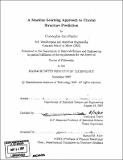A machine learning approach to crystal structure prediction
Author(s)
Fischer, Christopher Carl
DownloadFull printable version (14.52Mb)
Other Contributors
Massachusetts Institute of Technology. Dept. of Materials Science and Engineering.
Advisor
Gerbrand Ceder.
Terms of use
Metadata
Show full item recordAbstract
This thesis develops a machine learning framework for predicting crystal structure and applies it to binary metallic alloys. As computational materials science turns a promising eye towards design, routine encounters with chemistries and compositions lacking experimental information will demand a practical solution to structure prediction. We review the ingredients needed to solve this problem and focus on structure search. This thesis develops and argues for a search strategy utilizing a combination of machine learning and modern quantum mechanical methods. Structure correlations in a binary alloy database are extracted using probabilistic graphical models. Specific correlations are shown to reflect well-known structure stabilizing mechanisms. Two probabilistic models are investigated to represent correlation: an undirected graphical model known as a cumulant expansion, and a mixture model. The cumulant expansion is used to efficiently guide Density Functional Theory predictions of compounds in the Ag-Mg, Au-Zr, and Li-Pt alloy systems. Cross-validated predictions of compounds present in 1335 binary alloys are used to demonstrate predictive ability over a wide range of chemistries - providing both efficiency and confidence to the search problem. Inconsistencies present in the cumulant expansion are analyzed, and a formal correction is developed. Finally, a probabilistic mixture model is investigated as a means to represent correlation in a compact way. The mixture model leads to a significant reduction in model complexity while maintaining a level of prediction performance comparable to the cumulant expansion. Further analysis of the mixture model is performed in the context of classification. Unsupervised learning of alloy classes or groups is shown to reflect clear chemical trends.
Description
Thesis (Ph. D.)--Massachusetts Institute of Technology, Dept. of Materials Science and Engineering, 2007. Includes bibliographical references (p. 137-147).
Date issued
2007Department
Massachusetts Institute of Technology. Department of Materials Science and EngineeringPublisher
Massachusetts Institute of Technology
Keywords
Materials Science and Engineering.